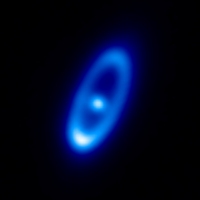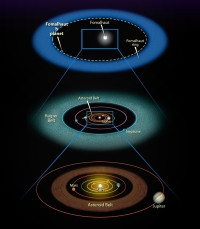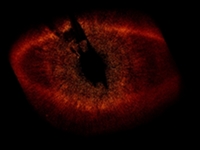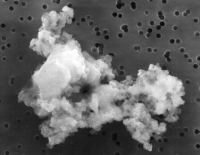Herschel images extrasolar analogue of the Kuiper Belt
11 April 2012
New images from ESA's Herschel Space Observatory reveal the glow from dust in the debris disc - a structure resembling the Kuiper Belt in the primordial Solar System - around the young star Fomalhaut. Detailed studies suggest that the dust in this debris disc consists of 'fluffy' aggregates of grains, which are produced by the frequent collisions taking place between comets within the disc.
 |
|
Herschel image of the star Fomalhaut and its debris disc. |
Collisions among these small bodies may be both frequent and violent, especially in the early formation phase of a planetary system. These collisions produce large amounts of dust grains, giving rise to circumstellar structures known as 'debris discs'. Astronomers can detect debris discs around stars other than the Sun both in visible light, as dust particles in the disc scatter the radiation emitted by the central star, or at longer wavelengths, via the thermal glow of dust itself. By studying these extrasolar debris discs, astronomers are collecting valuable insight into the nature of exoplanetary systems.
 |
|
Relative sizes of Fomalhaut's debris disc, the outer and inner Solar System. Credit: NASA, ESA, and A. Feild (STScI) |
Astronomers first detected an excess of infrared light corresponding to Fomalhaut's position with the Infrared Astronomical Satellite (IRAS) in the 1980s, which they interpreted as a debris disc surrounding the star. Ever since, this source has been the subject of extensive observations, including studies performed with the NASA/ESA Hubble Space Telescope in the past decade, where the starlight had been blocked by making use of a coronagraph in order to see fainter features in the disc. The Hubble image also suggested the presence of a planet around this star, although the nature of this detection is still under debate. Now a team of astronomers led by Bram Acke from the University of Leuven, Belgium, has used ESA's Herschel Space Observatory to look at the glow from Fomalhaut's disc at far-infrared and sub-millimetre wavelengths, achieving the first images of this debris disc in this portion of the spectrum.
"Herschel has allowed us to see the emission from Fomalhaut's debris disc in all its glory," comments Acke. Both the star and a smooth ring-like structure – the debris disc – are distinctly visible in the data from Herschel's shortest wavelength channel at 70 micron, where highest resolution can be achieved. Emission from the disc is clearly detected also in four other channels – 160, 250, 350 and 500 micron, respectively. "Observations at all five wavelengths are crucial to learn more about the properties of dust in the disc," notes Acke.
 |
|
Hubble image of Fomalhaut's debris disc. Credit: NASA, ESA, and P. Kalas (University of California, Berkeley, USA) |
"Combining both Herschel and Hubble data, we figured out that dust in Fomalhaut's debris disc must behave like small grains in terms of emission and absorption, but it must scatter light like large grains do," explains co-author Michiel Min from Utrecht University and the University of Amsterdam. "A form of dust that combines all these properties together consists of 'fluffy' aggregates: large conglomerates of small dust grains with lots of empty space in the structure," adds Min.
 |
|
A 'fluffy' aggregate of dust grains. Credit: NASA. |
The radiation pressure exerted by the star, however, is expected to blow out small dust particles very efficiently, expelling grains from the disc immediately after they are produced by comet collisions. "Since we do observe emission from dust in the disc, this blow-out effect must be compensated by a steady production of dust particles via comet collisions," notes co-author Carsten Dominik from the University of Amsterdam and Radboud Universiteit Nijmegen. "We estimate that the required amount of dust can be produced by an average rate of 2000 daily collisions between comets with a size of one kilometre across," Dominik adds. Alternatively, the same rate of dust production could be achieved if two 10-kilometre-diameter comets were to collide every day.
Using these calculations, the astronomers have estimated how many comets are stored in this extrasolar reservoir. "It appears that the total mass of Fomalhaut's debris disc amounts to 110 times the mass of the Earth, which translates into a very large number of comets, ranging between 1011 and 1013, depending on their sizes," explains Acke. This is comparable to the mass of the primordial Kuiper Belt, which astronomers estimate to be of the order of 30 Earth masses.
"The spectacular Herschel images of Fomalhaut's debris disc gives us an unprecedented view of this extrasolar Kuiper Belt," comments Göran Pilbratt, Herschel Project Scientist at ESA. "The study of the disc's dust content, based on both Herschel and Hubble data, demonstrates once more the fruitful synergy of probing the sky at very different wavelengths," he concludes.
Notes for editors
The study presented in this article is based on observations performed with the PACS and SPIRE instruments on board Herschel. Herschel is an ESA space observatory with science instruments provided by European-led Principal Investigator consortia and with important participation from NASA.
The PACS instrument contains an imaging photometer (camera) and an imaging spectrometer. The camera operates in three bands centred on 70, 100, and 160 μm, respectively. PACS has been developed by a consortium of institutes led by MPE (Germany) and including UVIE (Austria); KU Leuven, CSL, IMEC (Belgium); CEA, LAM (France); MPIA (Germany); INAF-IFSI/OAA/OAP/OAT, LENS, SISSA (Italy); IAC (Spain). This development has been supported by the funding agencies BMVIT (Austria), ESA-PRODEX (Belgium), CEA/CNES (France), DLR (Germany), ASI/INAF (Italy), and CICYT/MCYT (Spain).
The SPIRE instrument contains an imaging photometer (camera) and an imaging spectrometer. The camera operates in three wavelength bands centred on 250, 350 and 500 μm, and so can make images of the sky simultaneously in three sub-millimetre colours. SPIRE has been developed by a consortium of institutes led by Cardiff Univ. (UK) and including Univ. Lethbridge (Canada); NAOC (China); CEA, LAM (France); IFSI, Univ. Padua (Italy); IAC (Spain); Stockholm Observatory (Sweden); Imperial College London, RAL, UCL-MSSL, UKATC, Univ. Sussex (UK); Caltech, JPL, NHSC, Univ. Colorado (USA). This development has been supported by national funding agencies: CSA (Canada); NAOC (China); CEA, CNES, CNRS (France); ASI (Italy); MCINN (Spain); SNSB (Sweden); STFC (UK); and NASA (USA).
Related publications
Acke, B., et al., "Herschel Images of Fomalhaut – An extrasolar Kuiper Belt at the height of its dynamical activity", 2012, Astronomy & Astrophysics, 540, A125. DOI:10.1051/0004-6361/201118581
Contacts
Bram Acke
Instituut voor Sterrenkunde, KU Leuven
Leuven, Belgium
Email: bram ster.kuleuven.be
ster.kuleuven.be
Phone: +32 16 327939
Michiel Min
Astronomical Institute, Utrecht University
and Astronomical Institute Anton Pannekoek, University of Amsterdam
The Netherlands
Email: m.min uva.nl
uva.nl
Phone: +31 20 525 8325
Carsten Dominik
Astronomical Institute Anton Pannekoek, University of Amsterdam
and Afdeling Sterrenkunde, Radboud Universiteit Nijmegen
The Netherlands
Email: dominik uva.nl
uva.nl
Phone: +31 6 43710210
Göran Pilbratt
Herschel Project Scientist
Research and Scientific Support Department
Science and Robotic Exploration Directorate
ESA, The Netherlands
Email: gpilbratt rssd.esa.int
rssd.esa.int
Phone: +31 71 565 3621



